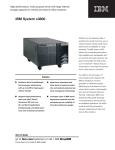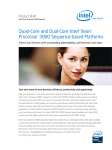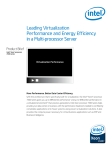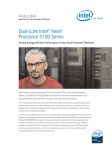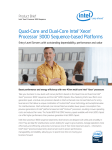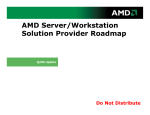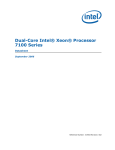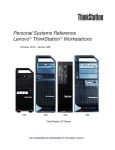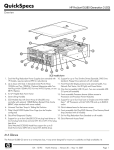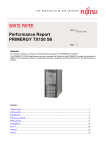Download Intel Quad-core Xeon E7330
Transcript
Product Brief Intel® Xeon® Processor 7300 Series Quad-Core Intel® Xeon® Processor 7300 Series Maximize Performance and Scalability in Multi-Processor Platforms Built for Virtualization and Data Demanding Applications Intel offers the industry’s first quad-core processors in volume production for multiprocessor server platforms, enabling scalable performance and proven reliability for data demanding enterprise applications and server consolidation in virtualized environments. Quad-Core Intel® Xeon® processor 73001 series provides IT managers the confidence and capability to consolidate onto fewer systems. The Capacity, Reliability, and Flexibility You Need for Virtualization Multi-processor platforms based on the Quad-Core Intel® Xeon® processor 7300 series and the Intel® Core™ microarchitecture enable IT managers to maximize data center performance and density. On a four socket platform, with up to 16 threads, 32- and 64-bit processing capabilities, and with up to 8 MB of L2 cache per processor,2 you can consolidate your data center onto fewer systems. This may be done while providing the peak load responsiveness needed for the unpredictability of virtualized applications. And, the energy efficiency gained from the Intel Core microarchitecture helps enable highly dense 80-watt or 50-watt processor-based rack and blade form factors. This allows you to take back control of data center cooling, power limitations, and space constraints caused by server sprawl. Offering maximum flexibility, IT managers can now build one compatible group of platforms for live migration across all of their Intel Core microarchitecturebased servers including 1p, 2p, and the new 4p Intel Xeon processor 7300 series-based servers. The ability to conduct live VM migration offers tremen dous flexibility for fail-over, load-balancing, disaster-recovery, and real-time server maintenance scenarios. And thanks to a new feature called Intel® VT FlexMigration, IT will have the capability to add future Intel® Xeon® processorbased systems to the same resource pool when using future versions of virtualization software. This gives IT the power to choose the right server platform to best optimize performance, cost, power and reliability. These processor enhancements are further supplemented by Intel® Networking technology improvements, such as Virtual Machine Device Queues (VMDq), which sort data through multiple queues in the silicon, resulting in efficient network processing. Multi-processor platforms based on the Quad-Core Intel Xeon processor 7300 series can deliver: • Up to 2.44 times the performance throughput in virtualized environments compared to the leading Dual-Core Intel® Xeon® processor 7100 seriesbased systems.3 Performance for Your Demanding Enterprise Applications Quad-Core Intel Xeon processor 7300 series-based platforms can help drive your data- and transactionintensive applications faster. This allows your business to know more, know it faster, and respond more quickly. With tremendous 64-bit performance and the broadest 32-bit application support, your data center can become more efficient and responsive to business needs. By delivering better performance for applications requiring reliable, large-scale computing solutions, you can deploy increasingly powerful business tools to track your marketplace and identify previously hidden opportunities. With 2x the cores, 4x the memory capacity,3 up to 8 MB of on-die L2 cache,2 dedicated high-speed interconnects (DHSI) and the performance-enhancing and energy-efficient technologies of the Intel Core microarchitecture, the Quad-Core Intel Xeon processor 7300 series-based servers provide more computing power and strong, scalable performance. Taken together, these capabilities help your well-threaded, data demanding applications to perform at their peak. Additional scalable performance includes: • Up to 1.86x performance improvement compared to two-socket Quad-Core Intel® Xeon® processor 5300 series-based servers4 • Up to 1.53x database, 1.78x enterprise resource planning (ERP), and 2.01x e-Commerce performance improvements compared to Dual-Core Intel® Xeon® processor 7100 series-based systems3 • Up to 3x performance/watt compared to Dual-Core Intel Xeon processor 7100 series-based systems3 • Up to 4x memory capacity improvement, compared to previous generations of this platform3 Quad-Core Intel Xeon Processor 7300 Series Overview Features Benefits Quad-Core Processing •Maximizes scalable performance and cost/virtual machines. •Increases performance and threading headroom for multi-threaded applications and heavy multi-tasking scenarios. •Helps boost system utilization through virtualization and application responsiveness.6 Intel® Core™ microarchitecture • Better performance on multiple application types and user environments as well as data-demanding workloads. • Reduced cooling challenges with performance per watt improvements, enabling denser data center deployments. Large 8 MB of on-die L2 Cache2 (2 x 4 MB) • Increases efficiency of L2 Cache-to-core data transfers, maximizing main memory to processor bandwidth and reducing latency. • Reduces latency by storing larger data sets closer to the processor, reducing the number of trips to main memory. •Up to 4 MB of L2 Cache can be allocated to one core. 1066 MT/s Dedicated High-Speed Interconnects (DHSI) •Fast, dedicated interconnects for increased throughput. Intel® 64 architecture5 •Flexibility for 64-bit and 32-bit applications and operating systems. Intel® Virtualization Technology6 •A processor hardware enhancement that assists virtualization software enabling more efficient virtualization solutions and greater capabilities including 64-bit guest operating system support. •The Quad-Core Intel® Xeon® processor 7300 series includes APIC Task Programmable Register, a new Intel® VT extension that improves interrupt handling further optimizing virtualization software efficiency. Demand-Based Switching (DBS) with Enhanced Intel SpeedStep® Technology7 •Helps reduce average system power consumption and potentially improves system acoustics. Find out more about Quad-Core Intel® Xeon® processors at www.intel.com/xeon What is the 7000 Sequence? At Intel, our processor series numbers help differentiate processor features beyond dedicated high-speed interconnects and brand name. New advancements in our processors – other than interconnect speed – like number of cores, architecture, cache, power dissipation, and embedded Intel® technologies, contribute significantly to performance, power efficiency, and other end-user benefits. Our processor sequences will help developers decide on the best processor for their platform designs, and help end-users understand all the characteristics that contribute to their overall experience. Intel Offers Four Processor Number Sequences for Server Applications Processor Sequence1 Used For Dual-Core and Quad-Core Intel® Xeon® processor 3000 sequence One-processor servers for small business, entry, or first server based on the Intel Xeon processor. Dual-Core and Quad-Core Intel® Xeon® processor 5000 sequence Two-processor general-purpose, standard high-volume servers and workstations based on the Intel Xeon processor. Dual-Core and Quad-Core Intel® Xeon® processor 7000 sequence Greater scalability with 4- to 32-processor enterprise servers based on the Intel Xeon processor. Dual-Core Intel® Itanium® 2 processor 9000 sequence Maximum performance and scalability for RISC replacement usage with 2- to 512-processor servers. Quad-Core Intel Xeon Processor 7300 Series The Quad-Core Intel Xeon processor 7300 series is available in a range of features to match different computing demands. All processors integrate Intel® Virtualization Technology6 and Intel® 64 architecture,5 and are available in the FC-mPGA6 packaging. Dual-core SKU options are also available for the large memory footprint requirements of certain high-performance computing and financial services applications. Processor Number1 Speed L2 Cache Dedicated High-Speed Interconnects Power DBS Quad-Core Intel® Xeon® Processor X7350 2.93 GHz 8 MB 1066 MT/s 130W Yes Quad-Core Intel® Xeon® Processor L7345 1.86 GHz 8 MB 1066 MT/s 50W No Quad-Core Intel® Xeon® Processor E7340 2.40 GHz 8 MB 1066 MT/s 80W Yes Quad-Core Intel® Xeon® Processor E7330 2.40 GHz 6 MB 1066 MT/s 80W Yes Quad-Core Intel® Xeon® Processor E7320 2.13 GHz 4 MB 1066 MT/s 80W Yes Quad-Core Intel® Xeon® Processor E7310 1.60 GHz 4 MB 1066 MT/s 80W No Dual-Core Intel® Xeon® Processor E7220 2.93 GHz 8 MB 1066 MT/s 80W Yes Dual-Core Intel® Xeon® Processor E7210 2.40 GHz 8 MB 1066 MT/s 80W Yes Maximize Performance with Quad-Core Intel® Xeon® Processor 7300 Series Baseline Dual-Core Intel® Xeon® Processor 7140M 1.0 Transaction Processing 1.53 SPECWeb*2005 1.59 SAP*-SD 2-Tier 1.78 SPECfp*_ rate_base2006 1.85 SPECjbb*2005 2.01 SPECint*_rate_base2006 2.44 Virtualization – vConsolidate 2.67 Performance per Watt measured by SPECint*_rate_base2006 3.09 0.0 0.5 1.0 1.5 2.0 2.5 3.0 Server Performance, Performance Per Watt and Virtualization Performance Per Watt Comparison using SPECint*_rate_base2006 benchmark: SSPECint*_rate_base2006 is a compute-intensive benchmark that measures the integer throughput performance of a computer system carrying out a number of parallel tasks. Performance Per Watt calculated by dividing the performance by the measured average power during the performance window. Configuration Details: Results published by Principled Technologies, Inc. at http://principledtechnologies.com/clients/reports/Intel/E7340SPECint0907.pdf as of September 5, 2007. Dual-Core Intel® Xeon® Processor 7140M-based platform details: Intel® SR4850HW4x Server Platform with four Intel Xeon processors 7140M 3.4GHz, 8 cores, 16MB L3 cache, 16GB memory PC2-5300 DDR2, disk Seagate* 1x146GB 15krpm SCSI, Microsoft Windows Server* 2003 Enterprise x64 Edition, SPEC binaries built with Intel Compiler 10.0. Quad-Core Intel® Xeon® Processor E7340-based platform details: Intel S7000FC4UR Server Platform with four Intel Xeon processors E7340 2.4GHz, 16 cores, 2x4MB L2 cache, 16GB memory PC25300 FB-DDR2, disk Seagate 1x73GB 10krpm SAS, Microsoft Windows Server 2003 Enterprise x64 Edition, SPEC binaries built with Intel Compiler 10.0. Performance Per Watt Comparison using SPECjbb*2005 benchmark: SPECjbb2005 (SPEC Java Business Benchmark 2005) benchmark description: Written in Java, this multi-threaded benchmark emulates an order processing environment in a company with multiple warehouses serving multiple customers. Measures average transaction throughput of a heavily loaded server. Performance reported in Business Operations per Second (BOPS). Performance Per Watt calculated by dividing the performance by the measured average power during the performance window. Configuration Details: Data Source: Published/measured results as of August 2007. Dual-Core Intel® Xeon® Processor 7140M-based platform details: Intel Server pre-production platform with four Dual-Core Intel® Xeon® Processor 7140M, 3.40 GHz with 16M L3 Cache, 800 MHz system bus, 16 GB (16x1GB) 667MHz FB-DIMM memory, Microsoft Windows Server 2003 Enterprise x64 Edition. BEA JRockit* 5.0 P27.2.0. Quad-Core Intel® Xeon® Processor X7350-based platform details: Intel Server pre-production platform with four Quad-Core Intel® Xeon® Processor L7345, 1.86 GHz with 2x4M L2 Cache, 1066 MHz system bus, 16 GB (16x1GB) 667MHz FB-DIMM memory, Microsoft Windows Server 2003 Enterprise x64 Edition. BEA JRockit* 5.0 P27.2.0. Benchmark Description for vConsolidate*: vConsolidate is a benchmark developed by Intel Corporation to measure Server Consolidation performance. This benchmark represents predominant use case of server application consolidation. Application types (web, database, mail, java) selected for consolidation are guided by market data. Benchmark scales through CSUs (Consolidated Stack Unit). One CSU = 5 virtual machines (4 application virtual machines and 1 idle virtual machine). Configuration Details: Performance measurement conducted by Virtual Iron and Intel Corporation as of August 2007. Dual-Core Intel® Xeon® Processor 7140M-based platform details: : Intel® Server Platform with four Dual-Core Intel Xeon processors 7140M 3.4GHz, 800 MHz system bus, 16MB L3 cache, Intel® E8500 chipset, 32GB memory DDR2 PC2-5300P, 14x Seagate* Cheetah* 36GB 15krpm Fibre Channel HDD, vConsolidate workload beta 2, Virtual Iron 4.0, profile 3. Maximum performance achieved using 2 CSUs. Quad-Core Intel® Xeon® Processor X7350-based platform details: Intel Server Platform with four Quad-Core Intel Xeon processors X7350 2.93GHz, 1066 MHz system bus, 8MB L2 cache, Clarksboro chipset, 32GB memory FBD PC2-5300F, 14x Seagate Cheetah 36GB 15krpm Fibre Channel HDD, vConsolidate workload beta 2, Virtual Iron 4.0, profile 3. Maximum performance achieved using 4 CSUs. Benchmark description for SPECint*_rate_base2006 benchmark: SPECint*_rate_base2006 is a compute-intensive benchmark that measures the integer throughput performance of a computer system carrying out a number of parallel tasks. Configuration details for SPECint_rate_base2006: Comparison based on published/submitted results to www.spec.org as of September 5, 2007. Dual-Core Intel® Xeon® Processor 7140M-based platform details: Fujitsu Siemens* PRIMERGY* RX600 S3 platform with four Intel Xeon processors 7140M 3.4GHz, 16MB L3 cache, 32GB memory PC23200R ECC, disk Fujitsu* SCSI 73GB 15krpm, 64-Bit SUSE* Linux* Enterprise Server 10 kernel 2.6.16.21-0.8-smp on an x86_64, Intel® C++ Compiler for IA32/EM64T application Version 9.1. Referenced as published at 75.5(SPECint*_rate_base2006) and 80.6(SPECint_rate2006). For more information see http://www.spec.org/cpu2006/results/res2007q2/cpu2006-20070402-00725.html. Quad-Core Intel® Xeon® Processor X7350-based platform details: IBM* System x3850 M2 Server platform with four Quad-Core Intel Xeon processors X7350 2.93GHz, 2x4MB L2 cache, 16 x 4GB DDR2PC5300, 64-Bit SUSE Linux Enterprise Server 10 SP1 Kernel linux, Intel C++ Compiler for Linux32 and Linux64 Version 10.1 Build 20070725. Results submitted to www.spec.org as of Sept 4th 2007 at 184(SPECint_rate_base2006). Benchmark description for SPECjbb*2005: SPEC Java Business Benchmark 2005 (jbb2005). Written in Java, this multi-threaded benchmark emulates an order processing environment in a company with multiple warehouses serving multiple customers. Measures average transaction throughput of a heavily loaded server. Performance reported in Business Operations per Second (BOPS). Configuration details for SPECjbb2005: Comparison based on published/submitted results to www.spec.org as of September 5, 2007. Dual-Core Intel® Xeon® Processor 7140M-based platform details: HP* ProLiant* ML570 G4 platform with four Dual-Core Intel Xeon processors 7140M 3.4Ghz, 16MB L3 cache, 32GB memory PC2-3200, Microsoft Windows Server* 2003 R2 Enterprise x64 Edition with SP1, BEA* JRockit* 5.0 P27.1.0 (build P27.1.0-7-71488-1.5.0_08-20061103-1228-windows-x86_64). Measured at 217,334 bops and 54,334 bops/JVM. For more information see http://www.spec.org/jbb2005/results/res2006q4/jbb2005-20061121-00222.html. (continued on back page) Application Responsiveness and Reliability with Intel® 7300 Series Chipsets with Data Traffic Optimizations The Intel® 7300 Chipset with data traffic optimizations improve data movement across Quad-Core Intel Xeon processor 7300 series-based servers by increasing interconnect bandwidth, optimizing system bandwidth, increasing memory capacity, and improving network traffic processing while reducing I/O latency as compared to previous platforms. All these platform advancements help to match the improved performance of the Quad-Core Intel Xeon processor 7300 series. The Intel 7300 Chipset has 28 lanes of PCI Express* with support for third-party expanders for additional I/O. New platform features enabled by the Intel 7300 Chipset with data optimization include: Dedicated High-Speed Interconnects (DHSI) • DHSI is an independent point to point interconnect between each of the four processors and the chipset. DHSI has increased the memory bandwidth by up to 2x over previous-generation multi-processor platforms.3 64 MB Snoop Filter • Significantly reduces data traffic on the DHSI providing lower latencies and greater available bandwidth. The snoop filter manages data coherency across processors with a directory of the current cached data, eliminating unnecessary snoops and boosting available bandwidth. Fully Buffered DIMM (FBDIMM) technology • Provides 4x the memory capacity3 (up to 256 GB based on 8 GB Fully Buffered DIMM). • Increases memory speed to 1066 MT/s. Intel® I/O Acceleration Technology (Intel® I/OAT) with next-generation improvements (using Intel® NIC) • Improves CPU utilization and lowers latency through features like low latency interrupts, MSI-X (next-generation interrupt handling) and stateless offloads. • Direct Cache Access (DCA) leverages Intel QuickData Technology in the Intel 7300 Chipset, a platform solution designed to maximize the throughput of server data traffic and achieve faster, scalable, and more reliable I/O. Reliable Uptime The Intel 7300 Chipset also builds in enhanced reliability to support continuous server availability and help prevent unplanned downtime. Reliability Feature Benefit Memory ECC Detects and corrects single-bit errors. Enhanced Memory ECC Retry double-bit errors. Memory Sparing Predicts a failing DIMM and copies the data to a spare memory DIMM, maintaining server availability and uptime. Memory Mirroring Data is written to two locations in system memory so that if a DRAM device fails, mirrored memory enables continued operation and data availability. Memory CRC Address and command transmissions are automatically retried if a transient error occurs. Symmetric Access to all CPUs Enables a system to restart and operate if the primary processor fails. Intel offers a complete line of industry-leading single- and multi-port Gigabit and Fast Ethernet controllers. For more information go to: http://www.intel.com/design/ network/products/lan/controllers/82575EB.htm (1 GbE) and http://www.intel.com/ design/network/products/lan/controllers/82598.htm (10 GbE). (continued from page 6) Quad-Core Intel® Xeon® Processor X7350-based platform details: Fujitsu Siemens* PRIMERGY* RX600 S4 platform with four Quad-Core Intel Xeon processors X7350 2.93GHz, 2x4MB L2 cache, 64GB memory (16x4GB), Microsoft Windows Server 2003 Enterprise x64 Edition SP1, BEA* JRockit* 6.0 P27.4.0 (build P27.4.0-3-86647-1.6.0_02-20070801-1931-windows-x86_64). Result submitted to www. spec.org for review as of September 5, 2007 at 437,412 bops and 54,677 bops/JVM. Benchmark Description for SPECfp*_rate_base2006: SPECfp*_rate_base2006 is a compute-intensive benchmark that measures the floating point throughput performance of a computer system carrying out a number of parallel tasks. Configuration Details for SPECfp*_rate_base2006: Published/submitted results to www.spec.org as of September 5, 2007. Dual-Core Intel® Xeon® Processor 7140M-based platform details: Intel Server pre-production platform with four Dual-Core Intel® Xeon® Processor 7140M, 3.40 GHz with 16M L3 Cache, 800 MHz system bus, 16GB (16x1GB) memory. 64-Bit SUSE LINUX Enterprise Server 10, Kernel. SPEC binaries built with Intel C++ Compiler for Linux64 version 9.1 Quad-Core Intel® Xeon® Processor X7350-based platform details: Lenovo* R630 G7 platform with four Quad-Core Xeon processors X7350 2.93GHz, 2x4MB L2 cache, 16GB memory (16x1GB Samsung* DDR2 5300F, 2 rank, CL5-5-5, ECC), disk Seagate* 1x73GB 10krpm SAS, 64-Bit SUSE Linux Enterprise Server 10 SP1 kernel linux-cbgm 2.6.16.43-0.5-smp for x86_64, Intel C++ Compiler for Linux32 and Linux64 Version 10.1 Build 20070725. Referenced as published at 108(SPECfp_rate_base2006) and 114(SPECfp_rate2006). Benchmark description for SAP-SD* two-tier: SAP-SD measures the performance of Enterprise resource planning servers using mySAP Business suite. It benchmark result is a measure of the number of SAP Sales and Distribution users (SAP-SD) supported by the server. Configuration details for SAP-SD: Comparison based on published/submitted results to www.sap.com as of September 5, 2007. Dual-Core Intel® Xeon® Processor 7140M -based platform details: HP* ProLiant* DL580 G4 platform with four Dual-Core Intel Xeon processors 7140M 3.4GHz, 2x1MB L2 cache, 16 MB L3 cache, 32GB memory, Microsoft Windows Server* 2003 Enterprise Edition (64-bit), Microsoft SQL Server* 2005 (64-bit), SAP* ECC Release 5.0 (64-bit). Referenced as published at 2,127 users. Certification 200606 (PDF 46KB). Quad-Core Intel® Xeon® Processor X7350-based platform details: HP* ProLiant* DL580 G5 platform with four Quad-Core Intel® Xeon® processors X7350 2.93GHz, 64GB memory, Microsoft Windows Server 2003, Microsoft SQL Server 2005, SAP ECC Release 6.0. Result submitted to www.sap.com as of 9/5/2007 at 3,705 users. Benchmark description for SPECweb*2005: SPECweb2005 is the SPEC* benchmark for evaluating the performance of World Wide Web Servers. SPECweb2005 consists of three separate, distinct workloads, each with its own submetric: SPECweb*2005_Banking, SPECweb*2005_Ecommerce, and SPECweb*2005_Support. The overall SPECweb2005 metric for a compliant result is the geometric mean of the three submetrics, normalized to a reference platform score. Configuration details for SPECWeb2005: Comparison based on published/submitted results to www.spec.org as of September 5, 2007. Dual-Core Intel® Xeon® Processor 7140M-based platform details: HP ProLiant* DL580 G4 platform server with four Intel® Xeon® processors 7140M 3.4GHz, 16Mb L3 cache, 64 GB memory (16x4GB, PC2-3200 DIMMs, DDR2-400 with Advanced ECC), RedHat Enterprise Linux* 5 (2.6.18-8.e15), Rock Web Server* v1.4.0 (x86_64). Referenced as published at 18,981. For more information see http://www. spec.org/web2005/results/res2007q2/web2005-20070409-00064.html Quad-Core Intel® Xeon® Processor X7350-based platform details: HP ProLiant* DL580 G5 with four Quad-Core Intel® Xeon® processors X7350 2.93GHz, 2x4MB L2 Cache, 64GB (16x4GB) FBDimm memory, RedHat Enterprise Linux*, Rock Web Server*. Result submitted to www.spec.org for review as of September 5, 2007 at 30,261. Benchmark Description for Transaction Processing: This application evaluates the capacity of a database server in supporting transaction processing. It simulates execution of user transactions against a database in an order-entry environment. Performance measured in transactions per second. Configuration Details: Data Source: Intel internal measurement. August 2007. Dual-Core Intel® Xeon® Processor 7140M based platform details: Intel Server pre-production platform with four Dual-Core Intel® Xeon® Processor 7140M, 3.40 GHz with 16M L3 Cache, 800 MHz system bus, Microsoft Windows 2003 Enterprise Edition. Quad-Core Intel® Xeon® Processor X7350 based platform details: Intel Server pre-production platform with four Quad-Core Intel® Xeon® Processor X7350, 2.93 GHz with 2x4M L2 Cache, 1066 MHz system bus, Microsoft Windows 2003 Enterprise Edition. Configuration details for DP to MP comparison: Benchmark Description for SPECint*_rate_base2006: SPECint*_rate_base2006 is a compute-intensive benchmark that measures the Integer throughput performance of a computer system carrying out a number of parallel tasks. Configuration Details for SPECint*_rate_base2006: Comparison to Quad-Core Intel® Xeon® processor X5365 based on published/submitted result as of September 5, 2007 Quad-Core Intel Xeon processor X5365 based platform details: Fujitsu Siemens* PRIMERGY* TX300 S3 with two Quad-Core Intel Xeon processors X5365 3.0 GHz, 1333 MHz system bus, 2x4MB L2 cache, memory 8GB (8x1GB) DDR2 PC2-5300F ECC, disk Seagate* ST3146854SS SAS 146GB 15krpm, SUSE* Linux* Enterprise Server 10 (x86_64) Kernel 2.6.16.21-0.8-smp, Intel® C++ Compiler for IA32/ EM64T application Version 10.0. Published in July 2007. Referenced as published at 98.9. For more infomation see www.spec.org/cpu2006/results/res2007q3/cpu2006-20070710-01408.html Quad-Core Intel® Xeon® processor X7350 based platform details: IBM* System x3850 M2 Server platform with four Quad-Core Intel Xeon processors X7350 2.93GHz, 2x4MB L2 cache, 16 x 4GB DDR2PC5300, 64-Bit SUSE Linux Enterprise Server 10 SP1 Kernel Linux, Intel C++ Compiler for Linux32 and Linux64 Version 10.1 Build 20070725. Results submitted to www.spec.org as of September 4th 2007 at 184. Performance tests and ratings are measured using specific computer systems and/or components and reflect the approximate performance of Intel products as measured by those tests. Any difference in system hardware or software design or configuration may affect actual performance. Buyers should consult other sources of information to evaluate the performance of systems or components they are considering purchasing. For more information on performance tests and on the performance of Intel products, visit http://www.intel.com/performance/resources/limits.htm or call (U.S.) 1-800-628-8686 or 1-916-356-3104. All dates and products specified are for planning purposes only and are subject to change without notice. Relative performance for each benchmark is calculated by taking the actual benchmark result for the first platform tested and assigning it a value of 1.0 as a baseline. Relative performance for the remaining platforms tested was calculated by dividing the actual benchmark result for the baseline platform into each of the specific benchmark results of each of the other platforms and assigning them a relative performance number that correlates with the performance improvements reported. SPECint2000 and SPECfp2000 benchmark tests reflect the performance of the microprocessor, memory architecture and compiler of a computer system on compute-intensive, 32-bit applications. SPEC benchmark tests results for Intel microprocessors are determined using particular, well-configured systems. These results may or may not reflect the relative performance of Intel microprocessor in systems with different hardware or software designs or configurations (including compilers). Buyers should consult other sources of information, including system benchmarks; to evaluate the performance of systems they are considering purchasing. Performance and competitive information is accurate at time of document publication. For latest competitive and performance information, visit www.intel.com/performance. 1 Intel® processor numbers are not a measure of performance. Processor numbers differentiate features within each processor series,not across different processor sequences. See http://www.intel.com/products/processor_number for details. 2 Each pair of cores integrates 4 MB of L2 Intel® Advanced Smart Cache. 3 Versus previous-generation processor. 4 erformance tests and ratings are measured using specific computer systems and/or components and reflect the approximate performance of Intel® products as measured by those tests. Any difference in P system hardware or software design or configuration may affect actual performance. Buyers should consult other sources of information to evaluate the performance of systems or components they are considering purchasing. For more information on performance tests and on the performance of Intel products, reference http://www.intel.com/performance/resources/benchmark_limitations.htm or call (U.S.) 1-800-628-8686 or 1-916-356-3104. 5 64-bit Intel® Xeon® processors with Intel® 64 architecture requires a computer system with a processor, chipset, BIOS, OS, device drivers and applications enabled for Intel 64 architecture. Processor will not operate (including 32-bit operation) without an Intel 64 architecture-enabled BIOS. Performance will vary depending on your hardware and software configurations. Intel 64 architecture-enabled OS, BIOS, device drivers and applications may not be available. Check with your vendor for more information. 6 Intel Virtualization Technology requires a computer system with a processor, chipset, BIOS, virtual machine monitor (VMM) and applications enabled for virtualization technology. Functionality, performance or other virtualization technology benefits will vary depending on hardware and software configurations. Virtualization technology-enabled BIOS and VMM applications are currently in development. 7 nhanced Intel SpeedStep® Technology for specified units of this processor available Q2/06. See the Processor Spec Finder at http://processorfinder.intel.com or contact your Intel representative for more E information. Information in this document is provided in connection with Intel products. No license, express or implied, by estoppel or otherwise, to any intellectual property rights is granted by this document. Except as provided in Intel’s Terms and Conditions of Sale for such products, Intel assumes no liability whatsoever, and Intel disclaims any express or implied warranty, relating to sale and/or use of Intel products including liability or warranties relating to fitness for a particular purpose, merchantability, or infringement of any patent, copyright or other intellectual property right. Intel products are not intended for use in medical, life saving, or life sustaining applications. Intel may make changes to specifications and product descriptions at any time, without notice. *Other names and brands may be claimed as the property of others. Copyright © 2007 Intel Corporation. All rights reserved. Intel, the Intel logo, Intel. Leap ahead., Intel. Leap ahead. logo, Xeon, Intel Core, Intel SpeedStep, and Intel Itanium are trademarks of Intel Corporation in the U.S. and other countries. Printed in USA 0907/HLW/OCG/PP/2.5K Please Recycle 318055-003US








